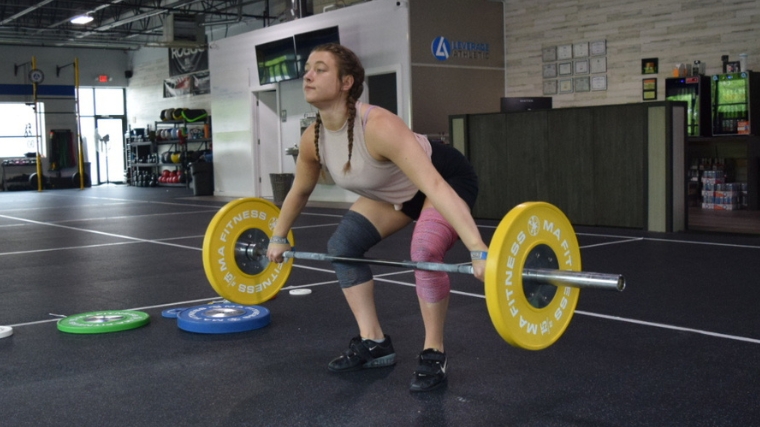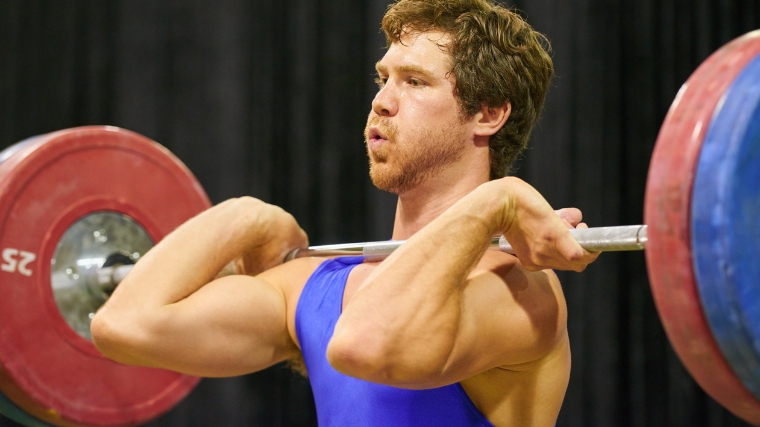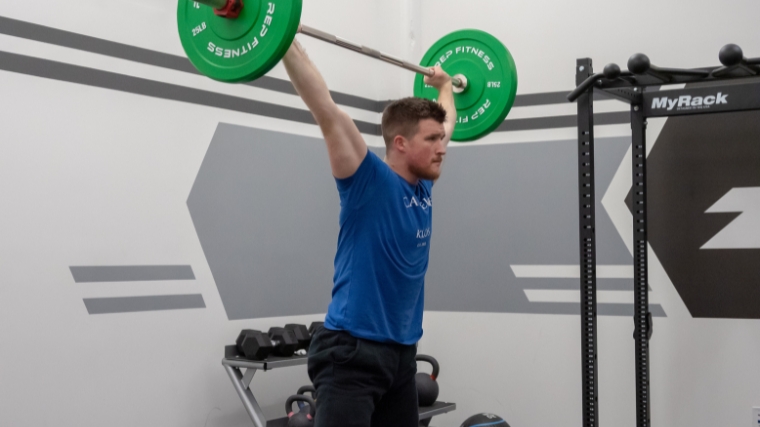[ad_1]
The barbell starts motionless on the floor at every weightlifting competition and ends up at arm’s length overhead. That’s the game; get an object from point “A” to point “B” as quickly and efficiently as you can. Oh, and make sure that bar is as heavy as possible as well.
However, training for success in the sport of weightlifting doesn’t always resemble the conditions of a competitive environment. Olympic lifters rely on all manner of tricks and tools to improve their performance, including — and perhaps, especially — changing how they pull on the barbell in the first place.

Weightlifting blocks and the hang position are two sides of the same coin. One is a tool meant to alter an athlete’s setup and execution of the snatch or clean & jerk; the other is a lifting technique that accomplishes the same thing. However, that doesn’t mean hang work is interchangeable with lifting off blocks. The devil is in the details, and understanding those details will help you perform better.
What Are Weightlifting Blocks?
First-day-in-the-gym beginners and Olympic Champions alike rely on segmenting the snatch and clean & jerk into their component parts while they learn and train. Particularly, the pull phase, during which the athlete lifts the barbell from the floor up to their thigh or hip.
Weightlifters use blocks to make this compartmentalization easier. Blocks are any stable, elevated surface upon which a weightlifter can rest a loaded barbell. They essentially adjust the starting height of the bar, shortening the range of motion of the pulling phase.
Most weightlifting blocks are made of wood and are constructed strongly enough to have loaded bars dropped on them from overhead. However, you can also use plyometric boxes, stall mats, and so on.
What Is the Hang Position?
During weightlifting competitions, the barbell can only move upward. Once you’ve lifted it off the platform and past your knees, you have no choice but to give it everything you’ve got, or you forfeit your attempt.
No such rule exists in training. The hang position refers to standing up with the barbell and then hinging over to lower it down to a specific height without it touching the ground again.
The most common hang position is the knee hang; from a standing position, the athlete shoots their hips back and allows the bar to slide down to knee level before reversing the motion and performing a snatch or clean. That said, you can hang as low or high as you like, as long as the barbell does not touch the floor.
Benefits of Blocks for Weightlifting
The biggest benefit of using blocks is obvious; doing so shortens your range of motion. However, that really only scratches the surface of why a weightlifter might opt to work off of blocks rather than lifting from the floor.
Helps Address Weak Points
Breaking your pull down into its component parts is the best way to address an issue or inconsistency in your technique. If, for example, you have trouble keeping the barbell close to your body as it passes your knee and moves up toward your hip, spending time and energy lifting from the floor is redundant and may impact your ability to focus on the issue at hand.
You can work around that issue in a literal sense by snatching or cleaning from knee-height blocks instead. With the barbell already at knee level, each repetition starts with the problem at hand. Blocks help you zone in on weaknesses by removing the need to demonstrate your strengths in the first place.
Train Power Development
Power — specifically, explosive and intense hip extension — is the hallmark of a successful weightlifter. Without violent lower-body extension, the barbell simply will not fly, and you won’t make many lifts if you can’t elevate it in the first place.
Lifting from the floor provides you with plenty of time to generate speed and momentum so, by the time the bar is in the right place, you can impart lots of force into it. Weightlifters intentionally use blocks to make this more difficult.
If you snatch or clean from knee or thigh-height blocks, you have less time to generate the requisite force to move your bar. This, very obviously, makes each repetition that much harder, since you can’t rely on a long, sweeping pull from the floor.
High-block (that is, blocks tall enough to suspend the barbell above knee height) power variations are commonplace in the early stages of a weightlifting program as a way of helping the athlete get in tune with their force output capabilities, rather than relying on pure strength or exquisite technique.
Useful for Beginners
Where an advanced weightlifter uses lifting blocks to improve their power output or remedy a technical weakness, the beginning weightlifter works off blocks to learn the fundamentals of the sport’s two competitive movements.
The snatch and the clean & jerk are among the most intricate and complex exercises you can do with a barbell. With so many moving parts, it’s easy for a beginner to feel overwhelmed.
Lifting blocks allow a coach (seriously, if you want to try weightlifting, you should do so under supervision) to take a new athlete through each aspect of the lifts step-by-step. You’ll have an easier time stringing together each stage of a good pull if you learn them separately first. Blocks provide you with the opportunity to do so.
A Workaround for Injury or Fatigue
Any veteran weightlifter will tell you that the pulling phases of the snatch and clean & jerk are more akin to a leg press than a deadlift. Your posterior chain is the framework, but your legs are the engine, particularly when pulling from the floor.
As such, blocks provide the weightlifter with a means of practicing the two lifts without exhausting their leg strength. Your quads work the hardest to get the bar from the floor to around knee height; lifting from knee blocks can spare your legs if they’re fatigued.

Alternatively and in some cases, block lifts may help a weightlifter continue to train through or around an injury. However, this is more of a case-by-case decision that a weightlifter makes with their coach, rather than a blanket prescription. At minimum, blocks allow you to omit certain ranges of motion that may be painful or cause discomfort.
You Can Lift Heavier
Intermediate and advanced weightlifters rely on block training as a means of exposing themselves to higher training intensities. Most weightlifting athletes can snatch or clean more weight off blocks than they can from the floor, especially if they use lifting straps to help their grip.
This is due to blocks, particularly knee-height blocks, enabling you to set up in a stronger position than you can get into when the bar is on the floor. A big lift off the blocks usually signals that the athlete might be ready to attempt a new personal record in a competitive setting.
Benefits of the Hang for Weightlifting
The hang position is great for much more than mimicking the utility of lifting blocks if you don’t have access to them. The act of holding the barbell in a specific position rather than suspending it on an elevated surface changes everything. Well, almost.
Great for Conditioning
If you partake in or follow CrossFit, you probably know that its programming borrows heavily from the sport of weightlifting. That said, you don’t see too much of the standard, competition-valid snatch and clean & jerk in most WODs.
On the other hand, hang variations are extremely common, especially as conditioning tools. It is generally easier and faster to transition between multiple hang lifts than it is to drop a barbell onto blocks, adjust it, and lift again.
As such, you can use exercises like the high hang power clean or hang snatch as part of a lifting complex or barbell cycling routine. As long as you keep your weights relatively light, it’s a good way to drill some technical practice while getting your sweat on.
Intuitive to Learn
Many newcomers to the sport of weightlifting struggle with the unique “feeling” of the snatch or clean & jerk. This is, in part, due to the two lifts having no eccentric component by default; you don’t lower the weights before lifting them, as you would during a squat or bench press.
As such, those new to the sport have limited tactile feedback to inform their posture or help them get a sense of how they’re moving. But by lifting from the hang rather than the floor, learners can get a sense of how it feels to load their posterior chains before pushing with their legs, among other types of valuable physical feedback.
A movement like the high hang power snatch bears some resemblance to a vertical jump or even a kettlebell swing, from a mechanics point of view. Hang variations help bridge the gap between movements a new trainee may be familiar with and the unique techniques they need to learn to succeed in the sport.
Reinforces Postural Strength
Many weightlifters use hang work to dial in their posture when they pull. There’s plenty that can go wrong when you yank the bar off the floor during the snatch or clean; your behind can shoot up, your knees might extend too early, or the bar can drift away from your body.
By starting at the top and working your way down, you can ensure that you hit every beat on your technical checklist. Hang lifts also provide you with postural reminders moments before you execute your pull; if you briefly identify how it feels to have your shoulders over the bar, you’re more likely to hit that exact spot again when you reverse your hang and extend upward.
Adds Eccentric Tension
The snatch and clean & jerk are unique, even as components of a strength sport. Notably, there’s almost no eccentric tension on any of your body’s major muscle groups while you lift.
Pushing off of the floor and recovering from a deep front or overhead squat are both eccentric movements. When you receive the bar during each lift, your muscles mostly contract isometrically to stabilize your joints and fix the barbell overhead (or in the front rack position).
As such, competition weightlifting is light on eccentric mechanical tension, which is an extremely important aspect of muscular hypertrophy. (1)(2) Exercises like the hang snatch or clean force your posterior chain to lengthen under load. This strengthens the structures in your spine, hips, and knees and adds some valuable time under tension as well.
Best Block and Hang Exercises for Weightlifting
If you’ve been sold on blocks and, more importantly, have access to them, the next step is identifying which variations of the snatch and clean & jerk are appropriate. Here are a few popular options for block (and hang) training.
Block Snatch (or Clean) Pull
Pulls are the bread and butter of weightlifting accessory training, perhaps second only to the squat. Snatch and clean pulls allow you to build postural strength, refine your technique, and get some training volume in without the rigors of catching the barbell and standing up with it.
Blocks are especially useful here if you want to go ultra-heavy. Low to mid-block pulls are great for strengthening your back and teaching yourself how to keep a heavy barbell close to your body.
Hang Power Clean
A good turnover separates average cleaners from great ones. Catching your barbell in a good front rack at exactly the right moment will make even a 1-rep max feel almost weightless.
This is the kind of quality that you can develop by working from the hang. An exercise like the hang power clean removes all of the unnecessary elements; you don’t need to pull from the floor, perform a heavy jerk, or do a front squat. All you have to do is nail your timing.
High Block Snatch
The third pull — when you move down to catch the barbell overhead — is the most difficult aspect of the snatch for many athletes, particularly beginners. It takes precision, focus, and lightning-fast reflexes to move from an extended position into a deep squat in the blink of an eye.
You can ante up on this challenge by setting up some thigh-height blocks to snatch off of. Doing so will rob you of almost all the momentum you normally generate by pulling from the floor. If you can’t transition quickly into your third pull, even a light barbell will feel impossibly heavy.
3-Position Hang Snatch (or Clean)
Weightlifting may be more than the sum of its parts, but working through those parts individually is the best way to learn. The three-position hang is among the most popular teaching tools for early weightlifting instruction, and for good reason.
A three-position hang involves performing three snatches or cleans from various hang heights back-to-back, starting from the thigh and working downward. The second rep lets you build on what you learned in the first, and so on.
Block Jerk
Blocks aren’t just for snatches or cleans. If you have access to them, jerk blocks are an indispensably-useful tool.
Jerks can be tricky to train on their own. After all, the bar starts in the front rack position. So, if you want to work on your jerk, you only have a few options. You can clean the bar every time and expend a bunch of energy, or work out of a squat rack, which can be clunky in a fatigued state.
Jerk blocks let you freely drop the bar between reps and pick it up again from about chest height. They let you pack in training volume without the inconvenience of doing the clean or having to delicately replace the bar in a rack.
The Building Blocks of Success
For a sport with such narrow performance criteria in competition, weightlifting training is notably diverse. If you want to succeed in the snatch or clean & jerk, you have to look beyond the barbell from time to time — or change how you work with it in the first place. Blocks and hang work both have their place, but knowing how each one affects your performance is the real key to success.
References
- Franchi, M. V., Reeves, N. D., & Narici, M. V. (2017). Skeletal Muscle Remodeling in Response to Eccentric vs. Concentric Loading: Morphological, Molecular, and Metabolic Adaptations. Frontiers in physiology, 8, 447.
- Pedrosa, G. F., Lima, F. V., Schoenfeld, B. J., Lacerda, L. T., Simões, M. G., Pereira, M. R., Diniz, R. C. R., & Chagas, M. H. (2022). Partial range of motion training elicits favorable improvements in muscular adaptations when carried out at long muscle lengths. European journal of sport science, 22(8), 1250–1260.
Featured Image: @catalystathletics / Instagram
[ad_2]
Source link
Fitnessnacks – #Weightlifting #Blocks #Hang #Differences
Courtesy : https://barbend.com/weightlifting-blocks-vs-hang/

